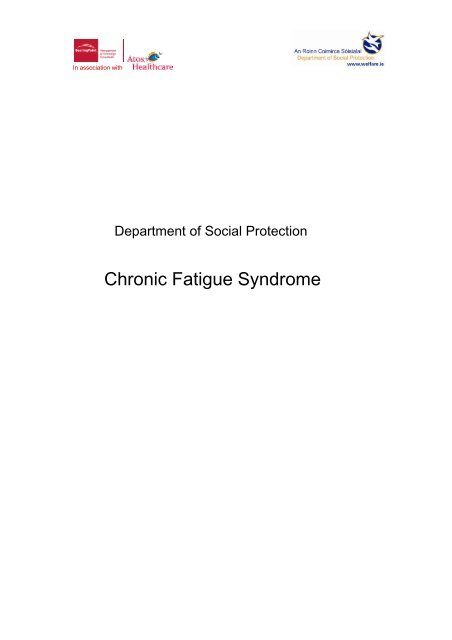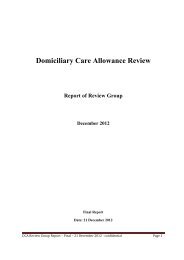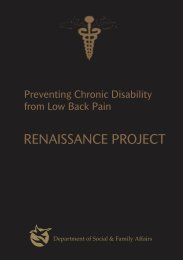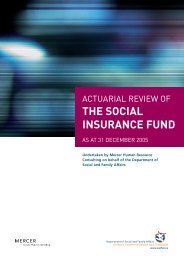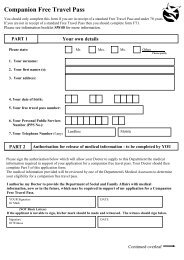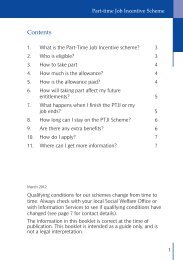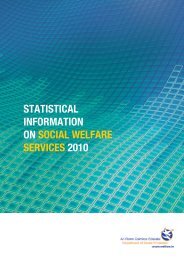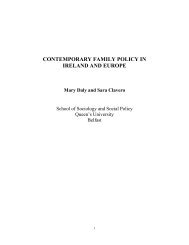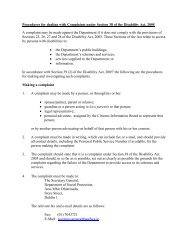Chronic Fatigue Syndrome - Welfare.ie
Chronic Fatigue Syndrome - Welfare.ie
Chronic Fatigue Syndrome - Welfare.ie
Create successful ePaper yourself
Turn your PDF publications into a flip-book with our unique Google optimized e-Paper software.
In association withDepartment of Social Protection<strong>Chronic</strong> <strong>Fatigue</strong> <strong>Syndrome</strong>
In association withContents1. Overv<strong>ie</strong>w and Definition of <strong>Chronic</strong> <strong>Fatigue</strong> <strong>Syndrome</strong> 41.1 Overv<strong>ie</strong>w 41.2 Definition of <strong>Chronic</strong> <strong>Fatigue</strong> <strong>Syndrome</strong> 51.2.1 International Consensus Definition of <strong>Chronic</strong> <strong>Fatigue</strong> <strong>Syndrome</strong> 51.2.2 Diagnostic and Statistical Manual of Mental Disorders 4 th Edition Text Revision(DSM-IV-TR) Classification 61.2.3 International Classification of Diseases; 10 th Edition (ICD-10) Classification 62. Epidemiology 83. Aetiology 93.1 Overv<strong>ie</strong>w 93.2 Immune Dysfunction and Infection 93.3 Physiology 93.4 Genetic 103.5 Life Events 104. Diagnosis 114.1 Clinical Features 114.2 Timing of Diagnosis 124.3 Physical Examination 134.4 Mental State Examination 134.5 Investigations 134.6 Conditions Which Exclude <strong>Chronic</strong> <strong>Fatigue</strong> <strong>Syndrome</strong> 144.7 Severity of Disorder 145. Differential Diagnosis and Comorbidity 165.1 Differential Diagnosis 165.2 Comorbidity 186. Treatment 196.1 Management Options for <strong>Chronic</strong> <strong>Fatigue</strong> <strong>Syndrome</strong> 196.2 Pharmacological interventions 196.3 Pain Management 206.4 Cognitive Behavioural Therapy 206.5 Graded Exercise Therapy 216.6 Activity Management 21BearingPoint, Atos Healthcare & DSPEBM <strong>Chronic</strong> <strong>Fatigue</strong> <strong>Syndrome</strong>Page 2CopyrightVersion:5.0 FINAL
In association with6.7 Pacing 216.8 Sleep Management 226.9 Relaxation 226.10 Nutrition and D<strong>ie</strong>t 227. Prognosis 247.1 Indicators of Good Prognosis 247.2 Indicators of Poor Prognosis 248. Information Gathering at the In Person Assessment 268.1 Assessing the Claimant 268.2 Physical examination 268.3 Mental Health Assessment 268.3.1 Assessment of Ability/Disability 269. Analysis of Effect on Functional Ability 289.1 Indicators of Severity of Ability/Disability 289.2 Ability/Disability Profile 3010. Summary of Scheme Criteria 3111. References and Bibliography 32BearingPoint, Atos Healthcare & DSPEBM <strong>Chronic</strong> <strong>Fatigue</strong> <strong>Syndrome</strong>Page 3CopyrightVersion:5.0 FINAL
In association with1. Overv<strong>ie</strong>w and Definition of <strong>Chronic</strong> <strong>Fatigue</strong><strong>Syndrome</strong>1.1 Overv<strong>ie</strong>w<strong>Chronic</strong> fatigue syndrome (CFS) / myalgic encephalomyelitis (or encephalopathy)(ME) is a not uncommon, complex debilitating disorder, characterised by severefatigue accompan<strong>ie</strong>d by a range of other symptoms. The disorder can be incrediblydebilitating to an individual – with the effects being as disabling as multiple sclerosis,chronic heart failure or rheumatoid arthritis (Turnbull et al, 2007). Although therehas been considerable research with respect to the disorder, the causes of chronicfatigue syndrome are still poorly understood (Reid et al, 2008).Severe and persistent fatigue as been reported by up to 20% of the population(Sharpe and Wessely, 2009) but the majority of these individuals do not seekmedical help with the condition. <strong>Chronic</strong> <strong>Fatigue</strong> <strong>Syndrome</strong> is a hugely disablingdisease, resulting in significant individual, social and economic costs. In the US, thecost of CFS to the economy in terms of lost productivity has been estimated at $9.1billion annually (Reynolds et al., 2004).The fact that the disorder is not well understood has led to differing thoughts as tothe nature of the disease. An older hypothesis was that the disease was ofpsychiatric origin. More recent thinking suggests that although the disease can bemulti-factorial in aetiology, it should be regarded as a neurological disorder ratherthan one of purely psychiatric nature. However, psychiatric comorbidity such asdepression and anx<strong>ie</strong>ty is common.As well as differing thoughts on the nature and aetiology of <strong>Chronic</strong> <strong>Fatigue</strong><strong>Syndrome</strong>, there continues to be a degree of dissent regarding terminology todescribe this disorder. Historically, <strong>Chronic</strong> <strong>Fatigue</strong> <strong>Syndrome</strong> (CFS) was usedinterchangeably with Myalgic Encephalomyelitis (ME) although some pat<strong>ie</strong>nt groupswould vehemently insist on their distinction. However the Ch<strong>ie</strong>f Medical Officer forEngland in 1998 (reporting in 2002) called for a consensus to be reached onterminology and definition, suggesting that the composite term CFS/ME is used todescribe what should be considered to be one condition or a spectrum of disease(Turnbull, 2007). However, representative part<strong>ie</strong>s still vary in name convention forthis disorder. Pat<strong>ie</strong>nt groups and medical literature often refer to the condition asME/CFS, just ME alone or <strong>Chronic</strong> <strong>Fatigue</strong> <strong>Syndrome</strong>. There is also dissent on theterm ME itself – whether this should be myalgic encephalomyelitis or myalgicencephalopathy (RCPCH, 2004).The variation in terminology is further compounded by the descriptions in the twomain diagnostic classification systems - which do not represent comparablediagnostic classifications. The International Classification of Diseases - ICD-10(WHO, 2007) – classif<strong>ie</strong>s the condition as a neurological disorder (G93.3) benignmyalgic encephalomyelitis. The American Psychiatric Association Diagnostic andStatistical Manual of Mental Disorders 4th Edition Text Revision (DSM-IV-TR) (2000)classif<strong>ie</strong>s the condition as undifferentiated somatoform disorder. There is aninternational consensus definition in use also, to define <strong>Chronic</strong> <strong>Fatigue</strong> <strong>Syndrome</strong>.BearingPoint, Atos Healthcare & DSPEBM <strong>Chronic</strong> <strong>Fatigue</strong> <strong>Syndrome</strong>Page 4CopyrightVersion:5.0 FINAL
In association withAll classifications have similar symptom descriptions, which further adds to theconfusion in definition, diagnosis and classification of the disorder (Sharpe andWessely, 2009).<strong>Chronic</strong> <strong>Fatigue</strong> <strong>Syndrome</strong> is the most commonly used term for this condition(Sharpe and Wessely, 2009).For the purposes of clarity, this protocol uses the term ‘<strong>Chronic</strong> <strong>Fatigue</strong><strong>Syndrome</strong>’, however this should be considered to also represent the termsCFS/ME, ME/CFS and ME alone.1.2 Definition of <strong>Chronic</strong> <strong>Fatigue</strong> <strong>Syndrome</strong><strong>Chronic</strong> <strong>Fatigue</strong> <strong>Syndrome</strong> is chronic, debilitating mental and physical fatigue whichis often triggered or exacerbated by activity. There is a wide variation in symptomsthat individuals with CFS exper<strong>ie</strong>nce, but these commonly include joint and musclepains, problems with concentration and memory, headaches, sore throat, tendercervical or axillary lymph nodes and unrefreshing sleep.Due to the issues stated above with the two main diagnostic classification systems,the most widely used definition of <strong>Chronic</strong> <strong>Fatigue</strong> <strong>Syndrome</strong> is based on a workingdefinition proposed by researchers into CFS (Sharpe and Wessely, 2009).1.2.1 International Consensus Definition of <strong>Chronic</strong> <strong>Fatigue</strong> <strong>Syndrome</strong>The International consensus definition of chronic fatigue syndrome (Fakuda et al.,1994) describes the disorder as having the following features:1. Complaint of fatigue - of new onset, not rel<strong>ie</strong>ved by rest, and lasting at least6 months.2. At least 4 of the following symptoms should be present:Subjective memory impairmentSore throatTender lymph nodesMuscle and joint painUnrefreshing sleepMalaise post exercise, lasting >24 hours3. Impairment of functioning4. Other conditions which may explain fatigue have been excluded.It should be noted there are several issues with this definition (Sharpe and Wessely,2009) including overlap with other medical and psychiatric illness, the exclusion ofBearingPoint, Atos Healthcare & DSPEBM <strong>Chronic</strong> <strong>Fatigue</strong> <strong>Syndrome</strong>Page 5CopyrightVersion:5.0 FINAL
In association withfatigue in pat<strong>ie</strong>nts with organic disease, and the fact that individuals with CFS havesuch a varying pattern of symptoms.Psychiatric disorders which have symptoms in common with CFS include:DepressionAnx<strong>ie</strong>ty DisordersNeurastheniaSomatoform disorders (DSM-IV-TR classification for CFS is ‘Undifferentiatedsomatoform disorder’)1.2.2 Diagnostic and Statistical Manual of Mental Disorders 4 th Edition Text Revision(DSM-IV-TR) ClassificationThe DSM-IV-TR (American Psychiatric Association, 2000) classif<strong>ie</strong>s chronic <strong>Fatigue</strong><strong>Syndrome</strong> as ‘undifferentiated Somatoform disorder’, with the following diagnosticcriteria.A. One or more physical complaints (e.g., fatigue, loss of appetite,gastrointestinal or urinary complaints).B. Either:(1) after appropriate investigation, the symptoms cannot be fullyexplained by a known general medical condition or the direct effects of asubstance (e.g., a drug of abuse, a medication)(2) when there is a related general medical condition, the physicalcomplaints or resulting social or occupational impairment is in excess ofwhat would be expected from the history, physical examination, orlaboratory findingsC. The symptoms cause clinically significant distress or impairment in social,occupational, or other important areas of functioning.D. The duration of the disturbance is at least 6 months.E. The disturbance is not better accounted for by another mental disorder(e.g., another Somatoform Disorder, Sexual Dysfunction, Mood Disorder,Anx<strong>ie</strong>ty Disorder, Sleep Disorder, or Psychotic Disorder).F. The symptom is not intentionally produced or feigned (as in FactitiousDisorder or Malingering).1.2.3 International Classification of Diseases; 10 th Edition (ICD-10) ClassificationAlthough the intent is that each disorder can be classif<strong>ie</strong>d in only one place in theICD-10 classification system (WHO, 2007), in practicality 96% of the symptoms ofBearingPoint, Atos Healthcare & DSPEBM <strong>Chronic</strong> <strong>Fatigue</strong> <strong>Syndrome</strong>Page 6CopyrightVersion:5.0 FINAL
In association with<strong>Chronic</strong> <strong>Fatigue</strong> <strong>Syndrome</strong> overlap between two codes in the diagnosticclassification. The recommendation currently is that <strong>Chronic</strong> <strong>Fatigue</strong> <strong>Syndrome</strong> isclassif<strong>ie</strong>d as G93.3 (Benign myalgic encephalomyelitis), however the description ofthe other relevant code (F48) has been included below for reference.G93.3 Benign myalgic encephalomyelitis – to be used where specific trigger suchas a viral disease and/or where the symptoms do not fulfil the criteria for F48.0(World Health Organization - UK Collaborating Centre, 2004).F48.0 Neurasthenia – which has the following diagnostic features:A. Either persistent and distressing complaints of increased fatigueafter mental effort, or persistent and distressing complaints of bodilyweakness and exhaustion after minimal effort;B. At least two of the following:feelings of muscular aches and painsdizzinesstension headachessleep disturbanceinability to relaxirritabilitydyspepsia;C. Any autonomic or depressive symptoms present are not suffic<strong>ie</strong>ntlypersistent and severe to fulfil the criteria for any of the more specificdisorders in this classification.It should be noted that the code F48.0 is little used in practice now (WHO, 2007).BearingPoint, Atos Healthcare & DSPEBM <strong>Chronic</strong> <strong>Fatigue</strong> <strong>Syndrome</strong>Page 7CopyrightVersion:5.0 FINAL
In association with2. EpidemiologyIt is widely agreed that, despite the var<strong>ie</strong>d range of statistics presented byepidemiological stud<strong>ie</strong>s on <strong>Chronic</strong> <strong>Fatigue</strong> <strong>Syndrome</strong>, prevalence cannot be statedprecisely. This is due to differing definitions and diagnostic criteria which have beenappl<strong>ie</strong>d to the condition, and to the variation in measurement of severity levels andoutcome measurement from study to study (Department of Health, 2003).Prevalence information also var<strong>ie</strong>s because many people do not seek formal helpfor the condition, or have not been correctly diagnosed with CFS (Merck Manuals,2008).Evidence suggests that the prevalence of CFS is underestimated – and mayrepresent only a small proportion of the extent of CFS occurrence. The Centers forDisease Control and Prevention in the US (2006) suggest that 80% of the cases ofCFS which occur are undiagnosed.The prevalence of <strong>Chronic</strong> <strong>Fatigue</strong> <strong>Syndrome</strong> in Ireland has not been researched.Estimates suggest that CFS affects approximately 10-12,000 individuals in Ireland(Foras Aiseanna Saothair, 2009, Irish ME Trust, 2009). This represents aprevalence rate of 0.2-0.4% which correlates to the reported prevalence rate in otherEuropean countr<strong>ie</strong>s.Prevalence rates from other stud<strong>ie</strong>s suggest rates of 0.006% to as high as 3.0% inprimary care (Afari, 2003).CFS affects four times as many women as men (NICE, 2007), but the prevalence isotherwise unaffected by race or socio-economic group.In adults, onset is typically early twent<strong>ie</strong>s to mid fort<strong>ie</strong>s age group. In children, onsetis typically between 13-15 years (Irish ME Trust, 2009).BearingPoint, Atos Healthcare & DSPEBM <strong>Chronic</strong> <strong>Fatigue</strong> <strong>Syndrome</strong>Page 8CopyrightVersion:5.0 FINAL
In association withbe similar to the changes often found in shift workers (Williams, 1996).Research into the hypothalamic-pituitary-adrenal axis (HPA) in CFS/MEpat<strong>ie</strong>nts suggests negative feedback and glucocorticoid receptor functionsare increased, whilst adrenocorticotropic hormone (ACTH) and cortisolresponses are decreasedCFS/ME pat<strong>ie</strong>nts can have significantly raised serum levels of tryptophanresulting in increased availability of the rate-limiting precursor of serotonin(Badawy et al, 2005)CFS/ME suffers often show abnormalit<strong>ie</strong>s in muscolo-skeletal and/orcardiovascular function.However, it is not clear as to if these changes are the cause or the effect of CFS/ME(Nye and Crawley, 2007). For example, changes in physical condition in terms ofskeletal, muscle or cardiovascular function could be due to periods of inactivityexper<strong>ie</strong>nced by the CFS/ME sufferer (Fulcher, 2000).3.4 GeneticClassic twin stud<strong>ie</strong>s have demonstrated a moderate heritable component to CFS/MEand other conditions of abnormal fatigue (Prins et al, 2006).3.5 Life EventsOther stressful life events or difficult<strong>ie</strong>s may precede development of CFS/ME,particularly if the stress is ongoing. Other factors may contribute to prolonging theillness, for example poor nutritional uptake, or a concurrent mood disorder.BearingPoint, Atos Healthcare & DSPEBM <strong>Chronic</strong> <strong>Fatigue</strong> <strong>Syndrome</strong>Page 10CopyrightVersion:5.0 FINAL
In association with4. DiagnosisMaking a diagnosis of <strong>Chronic</strong> <strong>Fatigue</strong> <strong>Syndrome</strong> involves a certain amount ofpragmatism (Sharpe and Wessely, 2009). The process of reaching a diagnosisoften involves excluding other causes of organic and psychiatric disease, in order tobe left with a recognisable set of characteristic symptoms which can best beexplained by the diagnosis of CFS. In order to ensure all other forms of illness areexcluded, a full medical and psychiatric assessment should be performed in allcases of suspected CFS (Sharpe and Wessely, 2009).The National Institute for Clinical Excellence stress the importance of a diagnosis tothe individual and their family, but state that any diagnosis of CFS should beconsidered as a provisional and working diagnosis only. This should be regularlyrev<strong>ie</strong>wed to ensure that serious underlying disease does not remain undetected(Turnbull et al, 2004).There are no specific laboratory tests or diagnostic evaluations that can beundertaken to confirm a suspected diagnosis of chronic disease syndrome, althoughthere is a panel of investigations that should be routinely performed when thedisorder is suspected (see section 4.4)4.1 Clinical FeaturesAlthough to a certain extent a diagnosis of “exclusion”, CFS/ME may berecognised on clinical grounds with a careful and structured history.Signs and symptoms that can be caused by other serious conditions should not beattributed to CFS/ME without consideration of alternative diagnoses or comorbidit<strong>ie</strong>s.These include:Localising/focal neurological signsSigns and symptoms of inflammatory arthritis or connective tissue diseaseSigns and symptoms of cardio-respiratory diseaseSignificant weight loss; significant obesitySleep apnoeaClinically significant lymphadenopathyMajor depressive disordersHypothyroidism.For further information on differential diagnoses for <strong>Chronic</strong> <strong>Fatigue</strong> <strong>Syndrome</strong>please see section 5.BearingPoint, Atos Healthcare & DSPEBM <strong>Chronic</strong> <strong>Fatigue</strong> <strong>Syndrome</strong>Page 11CopyrightVersion:5.0 FINAL
In association withOnce serious conditions have been discounted, CSF/ME should be considered if theindividual exhibits features which meet the diagnostic criteria outlined below. Itshould be noted that although this diagnostic description is generally used for CFS,it was originally formulated for research purposes. The definition is thereforerecognised to be in adequate in some respects for clinical care.<strong>Chronic</strong> <strong>Fatigue</strong> <strong>Syndrome</strong> should be considered if there is:FATIGUE with all of the following features:New or had a specific onset (that is, it is not lifelong fatigue)Persistent and/or relapsing or recurrent patternUnexplained by other conditionsHas resulted in a substantial reduction in previous levels of occupational,educational, social or personal activit<strong>ie</strong>s.Not substantially alleviated by restANDFour or more of the following symptoms, which are current, have persisted for morethan six months, and did not occur prior to the fatigue:Post-exertional malaise and/or fatigue after normal activity (typically for atleast 24 hours, with slow recovery over several days)Difficulty with sleeping, such as insomnia, hypersomnia, unrefreshingsleep, a disturbed sleep-wake cycleMuscle and/or joint pain that is multi-site and without evidence ofinflammationHeadaches of a new type, pattern or severityPainful lymph nodes without pathological enlargementSore throatCognitive dysfunction, such as difficulty thinking, inability to concentrate,impairment of short-term memory, and difficult<strong>ie</strong>s with word-finding,planning/organising thoughts and information processing(Fakuda et al, 1994)4.2 Timing of DiagnosisOne of the conditions of the International Consensus definition (Fakuda et al, 1994),is that the fatigue exper<strong>ie</strong>nced by the individual should have lasted at least 6BearingPoint, Atos Healthcare & DSPEBM <strong>Chronic</strong> <strong>Fatigue</strong> <strong>Syndrome</strong>Page 12CopyrightVersion:5.0 FINAL
In association withmonths.A number of Authorit<strong>ie</strong>s have commented that this time limit is not clinicallyappropriate, and that the six month time barr<strong>ie</strong>r should be considered as the endpoint by which the diagnosis should have been confirmed (Department of Health,2003; Turnbull et al, 2007). NICE guidance recommends that referral to specialistsin <strong>Chronic</strong> <strong>Fatigue</strong> <strong>Syndrome</strong> should be made immediately in people with severesymptoms, within three months for individuals who present with moderatesymptoms, and within six months for individuals with mild symptoms.These referral limits differ for paediatric and adolescent cases.4.3 Physical ExaminationA physical examination should be performed, but it should be noted that this may notreveal any abnormalit<strong>ie</strong>s.4.4 Mental State ExaminationA thorough mental state examination should be performed to identify changes inmood, intellectual function, memory, and personality. Any symptoms of depressionor anx<strong>ie</strong>ty should be identif<strong>ie</strong>d.The examination should aim to identify any psychiatric or neurological disorder thatmay account for the chronic fatigue. Referral for further psychological orneurological evaluation may be required.4.5 InvestigationsWhere symptoms suggest CFS/ME, the following tests should usually be done:Urinalysis for protein, blood and glucoseFull blood countUrea and electrolytesLiver functionThyroid functionErythrocyte sedimentation rate or plasma viscosityC-reactive proteinRandom blood glucoseSerum creatinineBearingPoint, Atos Healthcare & DSPEBM <strong>Chronic</strong> <strong>Fatigue</strong> <strong>Syndrome</strong>Page 13CopyrightVersion:5.0 FINAL
In association withScreening blood tests for gluten sensitivitySerum calciumCreatine kinaseAssessment of serum ferritin levels (children and young people only) ifindicated by full blood count results.Serological testing is not required unless the history is suggestive of an infection.Clinical judgement should be used to decide if additional investigations are required,in order to exclude other diagnoses.4.6 Conditions Which Exclude <strong>Chronic</strong> <strong>Fatigue</strong> <strong>Syndrome</strong>In addition to consideration of differential diagnoses, a number of criteria are definedas part of the International Consensus definition (Fakuda et al, 1994) which meanthat the diagnosis of <strong>Chronic</strong> <strong>Fatigue</strong> <strong>Syndrome</strong> should be ruled out. These are:Any active medical condition which explains the presence of chronic fatiguee.g. hypothyroidismAny previous medical condition which may be unresolved and explainongoing fatigue e.g. hepatitis infectionAny past or present diagnosis of psychiatric conditions which may explainthe fatigue e.g. depressive disorder, anorexia etc.Alcohol or other substance abuse within 2 years before the onset of thechronic fatigue and at any time afterwardSevere obesity (defined as a body mass index (weight kilograms/[height inmeters] 2 ) of greater than 45)4.7 Severity of DisorderThe individual may report different signs and symptoms dependent on the severity ofthe condition. The degree to which CFS/ME affects a person's functioning and daily lifehas been the basis for grading CSF/ME as mild, moderate or severe (Carruthers et al,2003):MildPeople with mild CFS/ME are mobile, can care for themselves and can do lightdomestic tasks albeit with occasional difficulty. Most are still working or in education,but to do this they have probably stopped all leisure and social pursuits. They oftentake days off, or use the weekend to cope with the rest of the week.ModerateBearingPoint, Atos Healthcare & DSPEBM <strong>Chronic</strong> <strong>Fatigue</strong> <strong>Syndrome</strong>Page 14CopyrightVersion:5.0 FINAL
In association withPeople with moderate CFS/ME have reduced mobility and are restricted in allactivit<strong>ie</strong>s of daily living, although they may have peaks and troughs in their level ofsymptoms and ability to do activit<strong>ie</strong>s. They have usually stopped work, school orcollege and need rest periods, often sleeping in the afternoon for 1 or 2 hours. Theirsleep at night is generally poor quality and disturbed.SeverePeople with severe CFS/ME are unable to do any activity for themselves, or can carryout minimal daily tasks only (such as face washing or cleaning teeth). They havesevere cognitive difficult<strong>ie</strong>s and depend on a wheelchair for mobility. They are oftenunable to leave the house, or have a severe and prolonged after-effect if they do so.They may also spend most of their time in bed, and are often extremely sensitive tolight and noise.BearingPoint, Atos Healthcare & DSPEBM <strong>Chronic</strong> <strong>Fatigue</strong> <strong>Syndrome</strong>Page 15CopyrightVersion:5.0 FINAL
In association with5. Differential Diagnosis and Comorbidity5.1 Differential DiagnosisThere is a fairly lengthy list of conditions which should be considered as a potentialdifferential diagnosis for <strong>Chronic</strong> <strong>Fatigue</strong> <strong>Syndrome</strong>. These conditions include:InfectiousEpstein-Barr virusLyme diseaseTuberculosisHIV/AIDSHepatitis B or CEndocrineHyperthyroidismHypothyroidismAddison's diseaseAdrenal insuffic<strong>ie</strong>ncyCushing's syndromeDiabetes mellitusPsychiatricPsychotic disorder (bipolar disorder, schizophrenia)Delusional disordersDepressive disordersSeasonal affective disorder (SAD)DementiaEating disorders (anorexia nervosa, bulimia nervosa)Alcohol or substance abuseNeuropsychologicalBearingPoint, Atos Healthcare & DSPEBM <strong>Chronic</strong> <strong>Fatigue</strong> <strong>Syndrome</strong>Page 16CopyrightVersion:5.0 FINAL
In association withMultiple sclerosisParkinson’s diseaseHaematologicalAnaemiaLymphomaRheumatologicalRheumatoid arthritisFibromyalgiaPolymyalgia rheumaticaRespiratoryBreathing disorders (hypoxia, hypercapnia)Sleep syndromes (narcolepsy, sleep apnoea)Nocturnal asthmaToxicityToxic exposure (heavy metals or lead)IrradiationOtherEndocarditisImmune or inflammatory diseaseMalignancyMetabolic/nutritional disorderNeurally-mediated hypotensionNeuromuscular disordersSomatoform disorderSystemic lupus erythematosusPharmacological side effects (e.g. antihistamines)BearingPoint, Atos Healthcare & DSPEBM <strong>Chronic</strong> <strong>Fatigue</strong> <strong>Syndrome</strong>Page 17CopyrightVersion:5.0 FINAL
In association with5.2 ComorbidityIndividuals with <strong>Chronic</strong> <strong>Fatigue</strong> <strong>Syndrome</strong> often have other accompanyingconditions, resulting in a complex clinical picture which may hinder diagnosis.Two of the most common comorbid disorders, depression and fibromyalgiasyndrome, share a number of symptoms with CFS/ME. Some authors havedescribed these as ‘overlapping’ diseases.Stud<strong>ie</strong>s have indicated there is a close link between depression and chronic fatiguesyndrome, although as CFS shares some symptoms with depression the exactrelationship between the two disorders is not clear. Stud<strong>ie</strong>s indicate around 66% ofindividuals with CFS have symptoms of major depressive illness with 50% ofindividuals reporting at least one episode of major depression.Other conditions which commonly exist with CFS include:Sleep disorders (40-80% of pat<strong>ie</strong>nts – but may be a symptom of CFS ratherthan a comorbid condition) (McPhee and Papadakis, 2009)Myo-fascial pain syndrome (MPS)Temporomandibular joint (TMJ) syndromeIrritable bowel syndrome (IBS)Irritable bladder syndrome , interstitial cystitisRaynaud’s syndromeProlapsed mitral valveMigraineAllerg<strong>ie</strong>s and/or multiple chemical sensitivit<strong>ie</strong>sHashimoto’s thyroiditisBearingPoint, Atos Healthcare & DSPEBM <strong>Chronic</strong> <strong>Fatigue</strong> <strong>Syndrome</strong>Page 18CopyrightVersion:5.0 FINAL
In association with6. TreatmentAlthough there is no specific treatment for CFS, most individuals will recover tosome extent, regaining some or all of their functional ability. However, this is likelyto be over a period of months or years. Treatment for <strong>Chronic</strong> <strong>Fatigue</strong> <strong>Syndrome</strong>focuses on educating individuals on rehabilitation, avoidance of precipitating factorsand easing the symptoms.<strong>Chronic</strong> <strong>Fatigue</strong> <strong>Syndrome</strong> is a disorder where ‘management’ is perhaps a moreappropriate term than ‘treatment’.6.1 Management Options for <strong>Chronic</strong> <strong>Fatigue</strong> <strong>Syndrome</strong>Management strateg<strong>ie</strong>s focus on four main areas:Pharmacological therap<strong>ie</strong>s aimed at symptom controlPsychological therap<strong>ie</strong>sLifestyle adjustments and strateg<strong>ie</strong>s to adjust for fatigue and minimiseexacerbation of the syndromeExercise therap<strong>ie</strong>sEvidence has shown that early diagnosis, balancing rest with activity, use ofmedication to control certain symptoms, and self-help measures can all help tovarying degrees. Other therap<strong>ie</strong>s which are useful include Cognitive behaviouraltherapy (CBT), graded exercise therapy (GET), activity management, pacing, sleepmanagement and relaxation, supported by pharmacological interventions, d<strong>ie</strong>t andnutrition and complementary therap<strong>ie</strong>s.6.2 Pharmacological interventionsPharmacological interventions should be aimed at addressing or controlling thesymptoms which are exper<strong>ie</strong>nced by individuals with <strong>Chronic</strong> <strong>Fatigue</strong> <strong>Syndrome</strong> asthere are no medication therap<strong>ie</strong>s which will directly treat the syndrome itself.The evidence base for pharmacological interventions for <strong>Chronic</strong> <strong>Fatigue</strong> <strong>Syndrome</strong>has been assessed by the National Institute for Clinical Excellence, which concludedmost stud<strong>ie</strong>s of this area were small, with very few suggesting a beneficial effect(Turnbull et al, 2007). Significant improvements for individuals with fatigue werefound in a trial of dexamphetamine but reduced food consumption was a side effect.For individuals who have disturbed sleep or suffer from pain, evidence suggests thatlow-dose tricyclic antidepressants, specifically amitriptyline, can be effective.However, these are contraindicated in individuals already taking selective serotoninreuptake inhibitors (SSRIs) due to the potential for serious adverse interactions.Individuals may well find the suggestion of a trial of antidepressant medicationunwelcome – this may reinforce a v<strong>ie</strong>w that their disorder is seen as psychologicalBearingPoint, Atos Healthcare & DSPEBM <strong>Chronic</strong> <strong>Fatigue</strong> <strong>Syndrome</strong>Page 19CopyrightVersion:5.0 FINAL
In association withor imaginary (Sharpe and Wessely, 2009).NICE have made a number of recommendations with respect to pharmacologicalinterventions which should NOT be used for the treatment of <strong>Chronic</strong> <strong>Fatigue</strong><strong>Syndrome</strong>:-Monoamine oxidase inhibitors (such as meclobamide)Glucocorticoids (such as hydrocortisone)Mineralocorticoids (such as fludrocortisone)Dexamphetamine (used in ADHD)Methylphenidate (used in ADHD)ThyroxineAntiviral agents.It should be noted that, although there is no evidence base to support this, there isanecdotal evidence that individuals with CFS report greater intolerance andincreased side effects to medication. Consideration should be given to starting anypharmacologic treatment at a lower dose than usual clinical practice, and increasingthe dose slowly in order to avoid intolerance or untoward side effects (Turnbull et al,2007)6.3 Pain ManagementA number of individuals with <strong>Chronic</strong> <strong>Fatigue</strong> <strong>Syndrome</strong> may suffer chronic pain. Ifthis is a predominant feature, referral to a pain management clinic should beconsidered.6.4 Cognitive Behavioural TherapyCognitive Behavioural Therapy is a specific psychological therapy, based onunderlying theoretical principles, with a broad evidence base across a var<strong>ie</strong>ty ofconditions. This therapy aims to reduce the levels of symptoms, disability anddistress associated with <strong>Chronic</strong> <strong>Fatigue</strong> <strong>Syndrome</strong>. CBT or psychologicalapproaches to this disorder do not imply that symptoms are psychological, 'made up'or in the pat<strong>ie</strong>nt's head, but is the most common treatment for <strong>Chronic</strong> <strong>Fatigue</strong><strong>Syndrome</strong>.It should be noted however, that although this therapy is used with many conditions(for example, depression, eating disorders, cardiac rehabilitation, diabetes, chronicpain) it is not a therapy which is effective for all individuals, and requires individualswho are skilled in the delivery of CBT techniques specifically for <strong>Chronic</strong> <strong>Fatigue</strong><strong>Syndrome</strong> (Sharpe and Wessely, 2009).CBT aims to address the factors which may be maintaining the individual’sBearingPoint, Atos Healthcare & DSPEBM <strong>Chronic</strong> <strong>Fatigue</strong> <strong>Syndrome</strong>Page 20CopyrightVersion:5.0 FINAL
In association withcondition, not the underlying causes. The treatment involves planned periods ofactivity and rest, a gradual increase in exercise and activity, and looking at bel<strong>ie</strong>fsand assumptions which may have an impact on the individual’s psychological health.The duration of therapy is usually around 12-16 sessions and may take place oversix months to a year. One-to-one therapy is advised (Turnbull et al, 2009)Indicators predictive of poor outcome from CBT include passive activity levels, poorsocial and occupational function prior to the onset of fatigue (Sharpe, 1998), whenan individual excessively focuses on symptoms (Prins, 2001). There is also someevidence to indicate that individuals who retire or claim disability benefit during theperiod of CBT will gain less benefit from the therapy (Deale, 1998).6.5 Graded Exercise TherapyGraded Exercise Therapy is a structured exercise plan, where a ach<strong>ie</strong>vable baselineof physical activity is agreed and gradually increased in order to ach<strong>ie</strong>ve aerobicactivity over time.Individuals are advised not to exceed the planned activity level. This therapyshould be undertaken by a suitably trained practitioner with exper<strong>ie</strong>nce of workingwith <strong>Chronic</strong> <strong>Fatigue</strong> <strong>Syndrome</strong>. If the individual exceeds the planned activity levels,or GET is introduced or progressed at too high a level, the individual can exper<strong>ie</strong>ncean exacerbation to their symptoms. There is some evidence to state there is a highdrop out level with GET – possibly as individuals with more severe <strong>Chronic</strong> <strong>Fatigue</strong><strong>Syndrome</strong> find any form of exercise problematic (Department of Health, 2001;Turnbull et al, 2007)6.6 Activity ManagementActivity Management aims to provide a structured plan to balance different activit<strong>ie</strong>s,rest and sleep. The plan may be on a daily or weekly basis and will look to spreaddemanding activit<strong>ie</strong>s over a longer period e.g. a week, and to break tasks down intosmall manageable parts (Department of Health 2001; Turnbull et al, 2007).6.7 PacingPacing is defined as energy management, with the aim of planning physical andcognitive function in order to balance activity and rest and avoid overexertion. Thethought is that if an individual uses the energy they do have effectively, then over alonger period their energy levels may increaseThere are a number of different definitions of pacing.There is no evidence to support pacing as a therapy, although it is anecdotallyreported by individuals to be of use (Turnbull et al, 2007). However, there is a largerandomised controlled clinical trial taking place which aims to compare pacing withCBT and graded exercise therapy in individuals with <strong>Chronic</strong> <strong>Fatigue</strong> <strong>Syndrome</strong>.BearingPoint, Atos Healthcare & DSPEBM <strong>Chronic</strong> <strong>Fatigue</strong> <strong>Syndrome</strong>Page 21CopyrightVersion:5.0 FINAL
In association withThe findings of the trial are due to be reported in late 2009. See www.pacetrial.org. .6.8 Sleep ManagementSleep Management includes techniques such as sleep hyg<strong>ie</strong>ne, which usesbehavioural approaches, and changes in environmental conditions which can beintroduced to improve the quality of sleep.Although individuals with <strong>Chronic</strong> <strong>Fatigue</strong> syndrome benefit from rest periods, daytime sleeping should not be encouraged as this will further exacerbate disorderedsleep patterns which are often exper<strong>ie</strong>nced by people with CFS.6.9 RelaxationRelaxation therap<strong>ie</strong>s can be a helpful strategy for people with <strong>Chronic</strong> <strong>Fatigue</strong><strong>Syndrome</strong>. There are a number of different techniques which can be of use forhelping with sleeping problems, stress or anx<strong>ie</strong>ty and the management of pain.Relaxation training and memory aids such as organisers and written resourcemanuals may also be helpful for addressing cognitive problems.6.10 Nutrition and D<strong>ie</strong>tD<strong>ie</strong>tary interventions including general supplements, pollen extract, medicinalmushrooms, acclydine (an alkaloid which stimulates the pituitary release of growthhormone), amino acids, essential fatty acid supplements and magnesiumsupplements have been shown to have unknown effectiveness.A group with post-viral syndrome did report an overall beneficial effect with essentialfatty acid supplements with improvements in symptom measures.Magnesium supplements had an overall positive effect of improvements inmeasures of energy and pain, emotional reactions, general health and laboratorymeasures, but not in sleep, physical mobility or social isolation.Individuals with CFS may have a var<strong>ie</strong>ty of issues with nutrition due to their condition(Turnbull et al, 1997), and should be referred to a d<strong>ie</strong>tician where appropriate.These issues include:Weight gain due to lack of mobilityWeight loss due to poor nutritionDifficulty eating due to fatigue and/or painDifficult or painful swallowing, sore throatNausea or sickness making food either undesirable or physically difficult toBearingPoint, Atos Healthcare & DSPEBM <strong>Chronic</strong> <strong>Fatigue</strong> <strong>Syndrome</strong>Page 22CopyrightVersion:5.0 FINAL
In association witheatIrritable bowel, digestion issuesFood intolerances leading to a restricted d<strong>ie</strong>tDisturbed sleep patterns causing meal patterns to be disruptedThe need for carers to help with food purchase, preparation and feeding.In extreme cases individuals may require tube feeding.BearingPoint, Atos Healthcare & DSPEBM <strong>Chronic</strong> <strong>Fatigue</strong> <strong>Syndrome</strong>Page 23CopyrightVersion:5.0 FINAL
In association with7. PrognosisThe prognosis for individuals with <strong>Chronic</strong> <strong>Fatigue</strong> <strong>Syndrome</strong> is variable. Peoplewith mild illness may recover spontaneously, or with some general advice or alimited treatment programme over a six month period. These people are likely to betreated in a general practice setting and recover before specialist referral is required.The majority of stud<strong>ie</strong>s into the prognosis of <strong>Chronic</strong> <strong>Fatigue</strong> <strong>Syndrome</strong> haveconcentrated on individuals being treated at specialist clinics (Reid et al, 2008).These stud<strong>ie</strong>s show a wide variation in recovery rates. Full recovery is thought tooccur in only 5-10% of individuals, with a further 40-60% ach<strong>ie</strong>ving a significantreduction in their symptoms over time (CDC, 2006, Cairns and Hotopf, 2005; Reid etal, 2008)7.1 Indicators of Good PrognosisIndicators of a good prognosis are:Early diagnosis and early initiation of treatmentMale sexA definite history of an acute viral illness (e.g. glandular fever)Mild disability and few symptomsClinical features showing a pattern of evolution towards functional recoveryA management approach which facilitates a gradual return to normal levelsof activity.7.2 Indicators of Poor PrognosisWhile indicators of a poor prognosis include:FemaleOnset of symptoms without any clear precipitating factor,Clinical course characterised by severe and unremitting symptoms,Severe and persistent disabilityComorbid significant medical conditions (e.g. fibromyalgia, fluid retentionsyndrome or irritable bowel syndrome)Comorbid psychiatric conditions (e.g. depression and anx<strong>ie</strong>ty)A complex background of adverse psychological and social factorsBearingPoint, Atos Healthcare & DSPEBM <strong>Chronic</strong> <strong>Fatigue</strong> <strong>Syndrome</strong>Page 24CopyrightVersion:5.0 FINAL
In association withManagement of the condition using excessive exercise or excessive restThe course of recovery is usually variable. Individuals will exper<strong>ie</strong>nce a pattern ofrelapse and remission which can vary significantly in their duration and severity.Long term significant disability is not uncommon.Although morbidity may be significant, there is no associated increase in mortality(Reid et al, 2008).BearingPoint, Atos Healthcare & DSPEBM <strong>Chronic</strong> <strong>Fatigue</strong> <strong>Syndrome</strong>Page 25CopyrightVersion:5.0 FINAL
In association with8. Information Gathering at the In PersonAssessment8.1 Assessing the ClaimantThe examining doctor should consider the information on file, informal observations,medical and psychiatric history, medication and other treatments, typical day,physical examination and mental state examination.Variability is an important factor to take into consideration when assessing someonewith CFS/ME. An attempt should be made to obtain a complete picture that includesa description of the claimant’s functional ability most of the time, as well as their bestand worst days.8.2 Physical examinationAs seen in the earl<strong>ie</strong>r chapters, the diagnosis of CFS/ME is based mainly on thereported symptoms, and in mild or moderate cases there will often be no significantclinical findings on examination.In severe cases, a degree of muscle wasting may be expected in the limbs.Remember that significant clinical findings such as neuropathy, arthropathy,glandular swelling and obesity would normally preclude a diagnosis of CFS/ME.Informal observations may confirm slowness of movement and cognition and thecorresponding need for assistance.8.3 Mental Health AssessmentIt is important to complete an appropriate mental health assessment in individualspresenting with CFS/ME. A detailed mental health history should be taken to includediagnosis, treatment, periods of hospitalisation etc. This may provoke a hostileresponse from claimants who consider their condition to be wholly physical in natureand must always be administered tactfully with an appropriate explanation.8.3.1 Assessment of Ability/DisabilityThe key areas to address in ability/disability assessment medicine relatemainly to functional ability in relation to day to day and workplace activit<strong>ie</strong>s.The recommended approach to assessing an individual’s functional ability is to askthem to describe their average day. Taking a history of a claimant’s average day,from the moment they awake to how they sleep, will allow an evaluation of thenature and severity of their disability in relation to simple tasks in terms ofcomprehension, learning, concentration, memory and motivation. It will also provideBearingPoint, Atos Healthcare & DSPEBM <strong>Chronic</strong> <strong>Fatigue</strong> <strong>Syndrome</strong>Page 26CopyrightVersion:5.0 FINAL
In association withan indication of any need for guidance, prompting or supervision. This informationalong with the other evidence obtained or provided will facilitate an overallassessment of disability in relation to the criteria for various scheme benefits. Thisanalysis stage is covered further in chapter 9 of the protocol.A number of areas are suggested under the four key headings below that should beexplored during the assessment, where relevant, through open questioning andobservation.Completion of tasksAnswering the phoneSetting an alarm clockOperating domestic appliancesReading a magazine or watching TVDriving a carHobb<strong>ie</strong>s and InterestsAccidents in the home – hazard awareness.Daily livingRising, washing, dressingCare over appearance/Self-NeglectFrequent mood fluctuation causing distress or panicNeed for alcohol early in the daySleep pattern.Coping with Pressure and ChangeInteraction with PeopleHistory of Work related stressConcerns that work may aggravate illnessSymptoms of fear and panicAvoidance of stressful activit<strong>ie</strong>s – going out, driving a carEffect of changes in routine<strong>Fatigue</strong>/Apathy or Disinterest – effect on activit<strong>ie</strong>s.Capability for self careIrritability/Disruption/AggressionCommunicating with peopleFear of going out aloneAvoidance of the company of other people.BearingPoint, Atos Healthcare & DSPEBM <strong>Chronic</strong> <strong>Fatigue</strong> <strong>Syndrome</strong>Page 27CopyrightVersion:5.0 FINAL
In association with9. Analysis of Effect on Functional AbilityEligibility to the Department of Social and Family Affairs various Illness-relatedschemes and Activation Programme, is determined primarily by the degree ofAbility/Disability and its expected duration.The degree of Ability/Disability assessed, using the following Indicators, can bedepicted on the Ability/Disability Profile illustrated below.9.1 Indicators of Severity of Ability/DisabilityNormalIn the recovery phase of CFS/MESleeping well at night and not during the dayNo restriction on walking distance or timeAble to carry out shopping and routine household tasksMildRemain mobile and self-caringPersonal grooming and hyg<strong>ie</strong>ne is unaffectedContinuing to perform some light household tasks with occasional difficultyMay need to take time out and rest to cope with activit<strong>ie</strong>sModerateSevereProfoundReduced mobility except for short distancesRestriction in performing all activity of daily livingVariability will still allow peaks and troughs in symptom levelsUnable to attend work , school or collegeWill need frequent rest periods and often sleep for 1-2 hours in the afternoonSleep at night is usually disturbed and of poor qualityOnly able to carry out minimal self-caring tasks (wash face, clean teeth)Significant problems with mobility even moving around indoorsProlonged recovery period needed after any undue activityImpaired concentration affects ability to perform simple tasksExtremely sensitive to bright light and loud noisesBearingPoint, Atos Healthcare & DSPEBM <strong>Chronic</strong> <strong>Fatigue</strong> <strong>Syndrome</strong>Page 28CopyrightVersion:5.0 FINAL
In association withOnly mobile in a wheelchairSpend most of their time in bedInactivity has resulted in muscle wastingBearingPoint, Atos Healthcare & DSPEBM <strong>Chronic</strong> <strong>Fatigue</strong> <strong>Syndrome</strong>Page 29CopyrightVersion:5.0 FINAL
In association with9.2 Ability/Disability ProfileIndicate the degree to which the Claimant’s condition has affected their ability inALL of the following areas.Mental health/BehaviourLearning/IntelligenceConsciousness/SeizuresBalance/Co-ordinationVisionHearingSpeechContinenceReachingManual dexterityLifting/CarryingBending/Kneeling/SquattingSittingStandingClimbing stairs/LaddersWalkingNormal Mild Moderate Severe ProfoundBearingPoint, Atos Healthcare & DSPEBM <strong>Chronic</strong> <strong>Fatigue</strong> <strong>Syndrome</strong>Page 30CopyrightVersion:5.0 FINAL
In association with10. Summary of Scheme CriteriaScheme eligibility criteria are maintained on the DSP website and are accessiblefrom the following links:Carer’s Allowancehttp://www.welfare.<strong>ie</strong>/EN/OperationalGuidelines/Pages/carers_all.aspxCarer’s Benefithttp://www.welfare.<strong>ie</strong>/EN/OperationalGuidelines/Pages/carers_ben.aspxDisability Allowancehttp://www.welfare.<strong>ie</strong>/EN/OperationalGuidelines/Pages/disall.aspxDisablement Benefithttp://www.welfare.<strong>ie</strong>/EN/OperationalGuidelines/Pages/oib_disableb.aspxDomiciliary Care Allowancehttp://www.welfare.<strong>ie</strong>/EN/Schemes/IllnessDisabilityAndCaring/Carers/DomiciliaryCareAllowance/Pages/DomiciliaryCareAllowance.aspxIllness Benefithttp://www.welfare.<strong>ie</strong>/EN/OperationalGuidelines/Pages/illben.aspxInjury Benefithttp://www.welfare.<strong>ie</strong>/EN/OperationalGuidelines/Pages/oib_injuryb.aspxInvalidity Pensionhttp://www.welfare.<strong>ie</strong>/EN/OperationalGuidelines/Pages/invalidity.aspxRespite Care Granthttp://www.welfare.<strong>ie</strong>/EN/OperationalGuidelines/Pages/respitegrant.aspxBearingPoint, Atos Healthcare & DSPEBM <strong>Chronic</strong> <strong>Fatigue</strong> <strong>Syndrome</strong>Page 31CopyrightVersion:5.0 FINAL
In association with11. References and BibliographyAfari N, Buchwald D. <strong>Chronic</strong> fatigue syndrome: a rev<strong>ie</strong>w. American Journal ofPsychiatry 2003, 160:(2)221–236 as cited by Department of Health (2006)‘Occupational Aspects of the Management of <strong>Chronic</strong> <strong>Fatigue</strong> <strong>Syndrome</strong>’Department of Health; London accessed athttp://www.dh.gov.uk/prod_consum_dh/groups/dh_digitalassets/@dh/@en/documents/digitalasset/dh_4139437.pdfAmerican Psychiatric Association (2000) ‘Diagnostic and statistical manual of mentaldisorders; 4th edn.’ Washington DC: The American Psychiatric Association. CairnsR, Hotopf M. (2005) ‘A systematic rev<strong>ie</strong>w describing the prognosis of chronic fatiguesyndrome’ Occupational Medicine 2005, 55:(1)20–31 as cited by Department ofHealth (2006) ‘Occupational Aspects of the Management of <strong>Chronic</strong> <strong>Fatigue</strong><strong>Syndrome</strong>’ Department of Health; London accessed athttp://www.dh.gov.uk/prod_consum_dh/groups/dh_digitalassets/@dh/@en/documents/digitalasset/dh_4139437.pdfBadawy AA, Morgan CJ, Llewelyn MB et al. Heterogeneity of serum tryptophanconcentration and availability to the brain in pat<strong>ie</strong>nts with the chronic fatiguesyndrome. J Psychopharm 2005; 19(4):385-91 as cited by Nye, F. Crawley, E.(2007) ‘<strong>Chronic</strong> fatigue syndrome: altered physiology and genetic influences’accessed at http://www.behindthemedicalheadlines.com/articles/chronic-fatiguesyndrome-altered-physiology-and-genetic-influences(article produced by Producedby the Royal College of Physicians of Edinburgh and Royal College of Physiciansand Surgeons of Glasgow)Carruthers BM, Jain AK, De Meirleir KL, Peterson DL, Klimas NG,Lerner AM et al. (2003) Myalgic encephalomyelitis/chronic fatigue syndrome: clinicalworking case definition, diagnostic and treatment protocols. Journal of <strong>Chronic</strong><strong>Fatigue</strong> <strong>Syndrome</strong> 2003; 11(1):7- 115Centres for Disease Control & Prevention. (2006) ‘<strong>Chronic</strong> <strong>Fatigue</strong> <strong>Syndrome</strong>: BasicFacts’ accessed at www.cdc.gov/cfsCentres for Disease Control & Prevention. (2006) ‘<strong>Chronic</strong> <strong>Fatigue</strong> <strong>Syndrome</strong>:Managing Activity’ accessed at www.cdc.gov/cfsCentres for Disease Control & Prevention. (2006) ‘<strong>Chronic</strong> <strong>Fatigue</strong> <strong>Syndrome</strong>:Managing Supportive Care’ accessed at www.cdc.gov/cfsCentres for Disease Control & Prevention. (2006) ‘<strong>Chronic</strong> <strong>Fatigue</strong> <strong>Syndrome</strong>:Managing Symptoms’ accessed at www.cdc.gov/cfsCentres for Disease Control & Prevention. (2006) ‘Diagnosing <strong>Chronic</strong> <strong>Fatigue</strong><strong>Syndrome</strong>’ accessed at www.cdc.gov/cfsDeale A, Chalder T, Wessely S. Illness bel<strong>ie</strong>fs and treatment outcome in chronicfatigue syndrome. Journal of Psychosomatic Research 1998, 45:77–83. as cited byDepartment of Health (2006) ‘Occupational Aspects of the Management of <strong>Chronic</strong><strong>Fatigue</strong> <strong>Syndrome</strong>’ Department of Health; London accessed atBearingPoint, Atos Healthcare & DSPEBM <strong>Chronic</strong> <strong>Fatigue</strong> <strong>Syndrome</strong>Page 32CopyrightVersion:5.0 FINAL
In association withhttp://www.dh.gov.uk/prod_consum_dh/groups/dh_digitalassets/@dh/@en/documents/digitalasset/dh_4139437.pdfFakuda et al (1994) ‘<strong>Chronic</strong> <strong>Fatigue</strong> <strong>Syndrome</strong> a comprehensive approach to itsdefinition and management’ in Annals of Internal Medicine 121:953-9 AmericanCollege of Physicians as cited in Sharpe, M. and Wessely, S. (2009) ‘<strong>Chronic</strong><strong>Fatigue</strong> <strong>Syndrome</strong>’ in Gelder, M. et al (Eds.) (2009) The New Oxford Textbook ofPsychiatry, Oxford University Press: OxfordForas Aiseanna Saothair (FAS – Training and Employment Agency) (2009) ‘MyalgicEncephalomyeltis (ME)’ accessed athttp://www.fas.<strong>ie</strong>/en/Useful+Links/Disability/Myalgic+Encephalomyeltis+(ME).htmSeptember, 2009Fulcher KY, White PD. Strength and physiological response to exercise in pat<strong>ie</strong>ntswith the chronic fatigue syndrome. J Neurol Neurosurg & Psychiat 2000; 69(3):302-7as cited by Nye, F. Crawley, E. (2007) ‘<strong>Chronic</strong> fatigue syndrome: altered physiologyand genetic influences’ accessed athttp://www.behindthemedicalheadlines.com/articles/chronic-fatigue-syndromealtered-physiology-and-genetic-influences(article produced by Produced by theRoyal College of Physicians of Edinburgh and Royal College of Physicians andSurgeons of Glasgow)Irish ME Trust (2009) ‘How prevalent is ME?’ accessed athttp://www.imet.<strong>ie</strong>/imet_website/what_is_me/how_prevelent_is_me.html September2009McCluskey DR. <strong>Chronic</strong> fatigue syndrome: its cause and a strategy formanagement. Compr Ther 1998;24:357-63. as cited by Craig T. and Kakumanu, S.(2002) ‘ <strong>Chronic</strong> <strong>Fatigue</strong> <strong>Syndrome</strong>: Evaluation and Treatment’ in American FamilyPhysician March 2002 accessed at http://www.aafp.org/afp/20020315/1083.htmlSeptember 2009McPhee, S. and Papadakis, M. ( 2009)’ Current Medical Diagnosis and Treatment; 2009’McGraw Hill; New York accessed athttp://books.google.co.uk/books?id=zQlH4mXSziYC&pg=PT54&dq=chronic+fatigue+syndrome+2009&as_brr=0#v=onepage&q=chronic%20fatigue%20syndrome&f=false September 2009Merck Manuals (Online Medical Reference Library) (2008) ‘<strong>Chronic</strong> <strong>Fatigue</strong><strong>Syndrome</strong>’ accessed athttp://www.merck.com/mmpe/sec22/ch334/ch334b.html#S22_CH334_T001September 2009Nye, F. Crawley, E. (2007) ‘<strong>Chronic</strong> fatigue syndrome: altered physiology andgenetic influences’ accessed athttp://www.behindthemedicalheadlines.com/articles/chronic-fatigue-syndromealtered-physiology-and-genetic-influences(article produced by Produced by theRoyal College of Physicians of Edinburgh and Royal College of Physicians andSurgeons of Glasgow)Prins JB, Bleijenberg G, Bazelmans E, Elving LD, De Boo TM, Severens JL, VanBearingPoint, Atos Healthcare & DSPEBM <strong>Chronic</strong> <strong>Fatigue</strong> <strong>Syndrome</strong>Page 33CopyrightVersion:5.0 FINAL
In association withDer Wilt GJ, Spinhoven P, Van Der Meer JWM. (2001) ‘Cognitive behaviour therapyfor chronic fatigue syndrome: a multicentre randomised controlled trial’ Lancet 2001,357:841–847 as cited Department of Health (2006) ‘Occupational Aspects of theManagement of <strong>Chronic</strong> <strong>Fatigue</strong> <strong>Syndrome</strong>’ Department of Health; Londonaccessedathttp://www.dh.gov.uk/prod_consum_dh/groups/dh_digitalassets/@dh/@en/documents/digitalasset/dh_4139437.pdfPrins, J. and Bleijenberg, G. (2006) <strong>Chronic</strong> <strong>Fatigue</strong> <strong>Syndrome</strong>’ in Lancet 367:346-55 as cited in Sharpe, M. and Wessely, S. (2009) ‘<strong>Chronic</strong> <strong>Fatigue</strong> <strong>Syndrome</strong>’ inGelder, M. et al (Eds.) (2009) The New Oxford Textbook of Psychiatry, OxfordUniversity Press: OxfordReeves WC, Jones JF, Maloney E, Heim C, Hoaglin DC,Boneva RS, Morrissey M, Devlin R. (2007) ‘Prevalence of chronic fatigue syndromein metropolitan, urban, and rural Georgia.’ Population Health Metrics 2007, 5:5 ascited by Merck Manuals (Online Medical Reference Library) (2008) ‘<strong>Chronic</strong> <strong>Fatigue</strong><strong>Syndrome</strong>’ accessed athttp://www.merck.com/mmpe/sec22/ch334/ch334b.html#S22_CH334_T001September 2009Reid, S, Chalder, T., Cleare, A., Hotopf, M., Wessely, S. (2008) ‘<strong>Chronic</strong> <strong>Fatigue</strong><strong>Syndrome</strong>’ BMJ Clinical Evidence accessed athttp://clinicalevidence.bmj.com/ceweb/conditions/msd/1101/1101.jsp September2009Reynolds KJ, Vernon SD, Bouchery E, Reeves WC. (2004) ‘The economic impact ofchronic fatigue syndrome’ Cost Effectiveness and Resource Allocation 2:4, 2004Royal Australasian College of Physicians (2002) ‘<strong>Chronic</strong> <strong>Fatigue</strong> <strong>Syndrome</strong>:Clinical Practice Guidelines’ Health Policy Unit: SydneyRoyal College of Paediatrics and Child Health (RCPCH) (2004) Evidence BasedGuideline for the Management of CFS/ME (<strong>Chronic</strong> <strong>Fatigue</strong> <strong>Syndrome</strong>/MyalgicEncephalopathy) in Children and Young People’ RCPCH; LondonSharpe M. Cognitive behavior therapy for chronic fatigue syndrome: efficacy andimplications. American Journal of Medicine 1998, 105:104S–109S Department ofHealth (2006) ‘Occupational Aspects of the Management of <strong>Chronic</strong> <strong>Fatigue</strong><strong>Syndrome</strong>’ Department of Health; London accessed athttp://www.dh.gov.uk/prod_consum_dh/groups/dh_digitalassets/@dh/@en/documents/digitalasset/dh_4139437.pdfSharpe, M. and Wessely, S. (2009) ‘<strong>Chronic</strong> <strong>Fatigue</strong> <strong>Syndrome</strong>’ in Gelder, M. et al(Eds.) (2009) The New Oxford Textbook of Psychiatry, Oxford University Press:OxfordTurnbull N, Shaw EJ, Baker R, Dunsdon S, Costin N, Britton G, Kuntze S andNorman R (2007). ‘<strong>Chronic</strong> fatigue syndrome/myalgic encephalomyelitis (orencephalopathy): diagnosis and management of chronic fatigue syndrome/myalgicencephalomyelitis (or encephalopathy) in adults and children’ London: RoyalCollege of General Practitioners Accessed at www.nice.org September 2009Wearden AJ, Appleby L. Research on cognitive complaints and cognitive functioningin pat<strong>ie</strong>nts with chronic fatigue syndrome (CFS): what conclusions can we draw? JBearingPoint, Atos Healthcare & DSPEBM <strong>Chronic</strong> <strong>Fatigue</strong> <strong>Syndrome</strong>Page 34CopyrightVersion:5.0 FINAL


